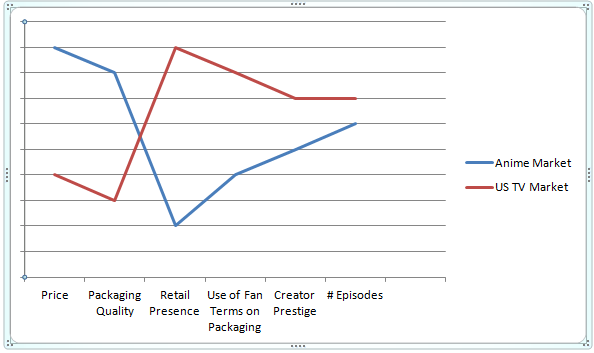Before we begin to determine where to position our hypothetical corporation in the market, it is prudent to analyze the current anime landscape. To do so, we construct a Strategy Canvas. A strategy canvas is a high-level view of a company in a competitive context. It captures where the current market currently invests its resources and its attention, and which factors they focus upon the most, from products to delivery.
Since the anime industry competes directly for the same dollars that are captured by western television, we will be placing both on the same strategy canvas, denoted by the red line in Figure 2-A:

Mind that this isn’t a perfect canvas, but rather a preliminary look at the greater market. A formal strategy canvas will be created as we travel further in this series and determine workable factors in the next chapter. These are the factors which are key to the industry’s sale and promotion of anime as a unique product for informed customers.
From the preliminary strategy canvas, we can gather the following data:
- Anime DVDs retail for significantly higher than that of the typical American DVD set.
- Anime DVDs maintain a higher standard of packaging (on average) than the typical American DVD set
- Both industries place a degree of importance on staff prestige when presenting titles to the public.
- American DVDs enjoy far greater retail penetration and general ubiquity than the typical anime release.
With this in mind, we can visualize the challenges of the market as a whole. When placed in direct competition with the anime industry, the industry faces challenges in pricing, in penetration, and in general mindshare of their product. A new market would need to be able to side-step these issues, while also defining new values for customers who may or may not be patrons of the existing industry.
The creation of value can be a number of factors, which can come from any number of possibilities. For example, simplifying the product, catering to a different audience, or adding a new convenience to the product are all possible avenues of value addition. This becomes especially important in the realm of blue ocean products, which see a trimming of costs and a search for alternate revenues in order to make the competition irrelevant.









